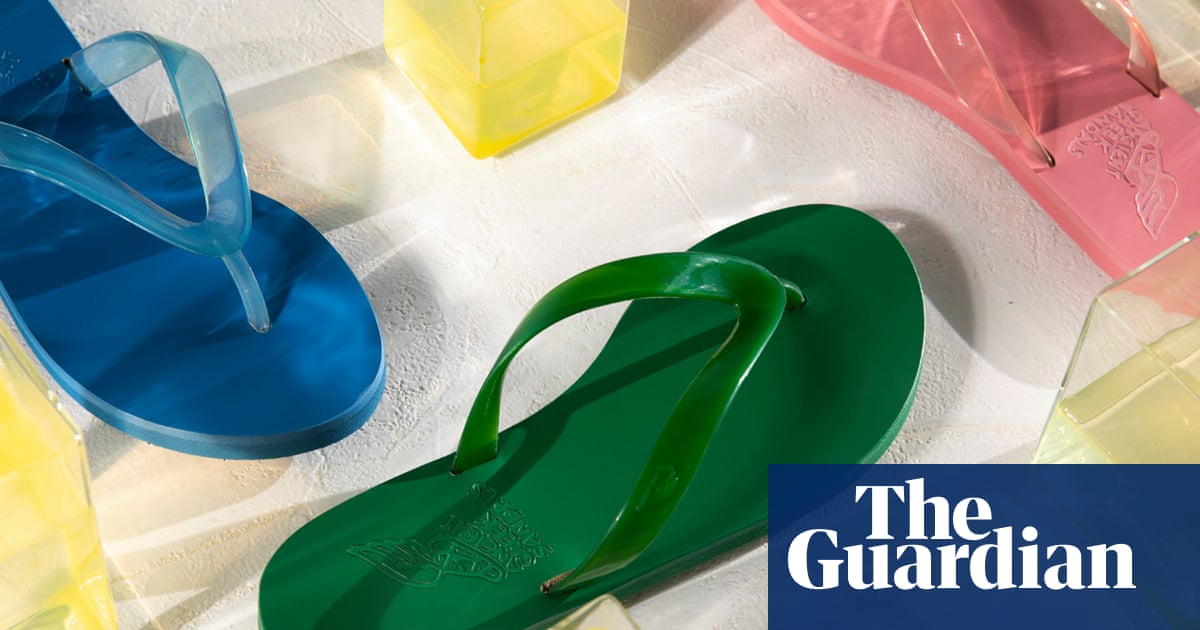They are typically worn around public swimming pools in the hope of avoiding a verruca. Or slipped on post-pedicure. Now, flip-flops are moving beyond communal showers and nail salons.
Along with rattling ice cubes in glasses of rosé, this summer’s soundtrack is gearing up to be peppered with the distinctive noise of flip-flops slapping pavements. Libby Jane Page, executive director of Vogue Shopping, describes the footwear style as having “endless appeal” hailing them a “summer staple”.
The catalyst for the trend? A pair of £670 flip-flops from the Row. Earlier this year, the luxury brand that is helmed by the child TV stars turned designers Mary-Kate and Ashley Olsen and who have a knack for turning basics (black trousers, white shirts, cashmere cardigans) into covetable pieces, includedflip-flops with a black fabric thong and red rubber solein their latest collection. Although many people were outraged by the triple-figure price tag, they quickly sold out. (There is now a waiting list.)
Elsewhere on the catwalks, there were jelly flip-flops at Chloé and smart leather iterations at Ferragamo. Coperni did a rubberised platform version, while Miu Miu deconstructed classic Mary Janes, chopping off the almond toe shape to add a flip-flop front.
Now the trickle-down effect has flooded the high street. Despite recent dismal weather, searches for flip-flops are up 44% at John Lewis. Bestsellers include a £14.40 black-soled version from Ipanema with a contrasting tortoiseshell thong. Over at M&S, square-toed suede and a leopard-print pairs are in high demand, though almost impossible to track down in stores (online ordering is still not available followinga cyberattack). Meanwhile, a £9.95 rubber pair from Muji are being hailed as the perfect dupe forChristopher Esber’s £250 plastic thongs.
“In handbags,” Page explains, “it’s always been about what luxury brand you’re carrying; in footwear it couldn’t be more different – the more democratic the better and it doesn’t get more laid-back than the flip-flop.”
During the Cannes film festival the model Irina Shayk was photographed hanging out around the Croisette in a £60 studded pair from Mango. Ancient Greek sandals are sellingbright rainbow-coloured jelly versionsfor £95, while the Brazilian OG Havaianas has teamed up with Dolce & Gabbana on a limited-edition collection spanning everything from faux fur to macramé straps (from £120). On Thursday Havaianas announced that the model Gigi Hadid had designed her own collection for the brand with hot orange and ombré styles from £25 the focus.
In the same way that Birkenstocks and then Crocs freed themselves from the “bin shoe” category of footwear (stored by the front door and worn for waste disposal purposes only), perhaps the great flip-flop revival suggests that we are reaching the final frontier of the ugly shoe trend.
They also tap into a widertoe-exposure trend, succeeding mesh ballet flats and shoes such as Vibram’s FiveFingers that frame each individual phalanx. With flip-flops, the toes have reached maximum display. “We are certainly in a phalangeal era,” says thefashion writer Liana Satenstein. “After all, we’ve seen cleavage, we’ve seen buttocks in the open, but feet? Whether your hooves are knobby or bunion-ridden, they can be perversely sexy, and people want to express that via a slappy flip-flop.”
While flip-flops may be being hailed as a new fashion trend, they are one of the earliest styles of shoes. Rebecca Shawcross, a senior curator at Northampton’sShoe Museum, points to a woven reeds pair from Egypt in their collection that “look so contemporary” but in fact, date from 350BC. Shawcross explains that flip-flops first infiltrated western fashion in the 1960s taking inspiration from Japanese thonged zori sandals. “This coincided with developments in the production of rubber. Manufacturers realised that a thong style of shoe made of rubber was easy and cheap to make.”
Sign up toFashion Statement
Style, with substance: what's really trending this week, a roundup of the best fashion journalism and your wardrobe dilemmas solved
after newsletter promotion
The popularity of the trend can also be pegged to the stylist Allison Bornstein’s “wrong shoe theory”, a styling hack that involves purposefully wearing an unexpected shoe.The Row’s lookbookshows their versions styled with jeans. Hailey Bieber has been pictured wearing Toteme flip-flops with low-rise tailored trousers, while the fashion influencer outfit of choice is jazzy trousers offset with casual minimalist flip-flops from A.Emery or Aeyde.
But as the flip-flop makes it way from beach bars to members’ club, the trend comes with a caveat. Helen Branthwaite, the chief clinical adviser for the Royal College of Podiatry, points out they are only a healthy choice of shoe for people with strong feet. “The style of a thong shoe alters foot function primarily as the way you walk needs to address the lack of fastening on to the foot.”
Flip-flops with more of an arch profile and structured sole from brands such as Archies Footwear and Birkenstock may have a better outcome. But Branthwaite says wearing any flip-flop style excessively could increase the risk of injury. “Adaptation occurs over a prolonged period of time and constant wearers of this style of shoe may find come the winter they can not then get a shoe or trainer on comfortably.” Her advice: “Variation is key and swapping around helps the foot remain strong whilst also being supported.”
With a heatwave on the way, flip-flop fans, you have been warned.
To read the complete version of this newsletter – complete with this week’s trending topics in The Measure and your wardrobe dilemmas solved –subscribe to receive Fashion Statementin your inbox every Thursday.
